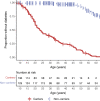A multigenerational study on phenotypic consequences of the most common causal variant of HNF1A-MODY
- PMID: 34951657
- PMCID: PMC8894160
- DOI: 10.1007/s00125-021-05631-z
A multigenerational study on phenotypic consequences of the most common causal variant of HNF1A-MODY
Erratum in
-
Correction to: A multigenerational study on phenotypic consequences of the most common causal variant of HNF1A-MODY.Diabetologia. 2022 May;65(5):912. doi: 10.1007/s00125-022-05663-z. Diabetologia. 2022. PMID: 35238956 Free PMC article. No abstract available.
Abstract
Aims/hypothesis: Systematic studies on the phenotypic consequences of variants causal of HNF1A-MODY are rare. Our aim was to assess the phenotype of carriers of a single HNF1A variant and genetic and clinical factors affecting the clinical spectrum.
Methods: We conducted a family-based multigenerational study by comparing heterozygous carriers of the HNF1A p.(Gly292fs) variant with the non-carrier relatives irrespective of diabetes status. During more than two decades, 145 carriers and 131 non-carriers from 12 families participated in the study, and 208 underwent an OGTT at least once. We assessed the polygenic risk score for type 2 diabetes, age at onset of diabetes and measures of body composition, as well as plasma glucose, serum insulin, proinsulin, C-peptide, glucagon and NEFA response during the OGTT.
Results: Half of the carriers remained free of diabetes at 23 years, one-third at 33 years and 13% even at 50 years. The median age at diagnosis was 21 years (IQR 17-35). We could not identify clinical factors affecting the age at conversion; sex, BMI, insulin sensitivity or parental carrier status had no significant effect. However, for 1 SD unit increase of a polygenic risk score for type 2 diabetes, the predicted age at diagnosis decreased by 3.2 years. During the OGTT, the carriers had higher levels of plasma glucose and lower levels of serum insulin and C-peptide than the non-carriers. The carriers were also leaner than the non-carriers (by 5.0 kg, p=0.012, and by 2.1 kg/m2 units of BMI, p=2.2 × 10-4, using the first adult measurements) and, possibly as a result of insulin deficiency, demonstrated higher lipolytic activity (with medians of NEFA at fasting 621 vs 441 μmol/l, p=0.0039; at 120 min during an OGTT 117 vs 64 μmol/l, p=3.1 × 10-5).
Conclusions/interpretation: The most common causal variant of HNF1A-MODY, p.(Gly292fs), presents not only with hyperglycaemia and insulin deficiency, but also with increased lipolysis and markedly lower adult BMI. Serum insulin was more discriminative than C-peptide between carriers and non-carriers. A considerable proportion of carriers develop diabetes after young adulthood. Even among individuals with a monogenic form of diabetes, polygenic risk of diabetes modifies the age at onset of diabetes.
Keywords: Age at onset; Glucagon; HNF1A-MODY; Insulin deficiency; Lipolysis; MODY3; Maturity-onset diabetes of the young (MODY); Monogenic diabetes; NEFA; Polygenic risk score for type 2 diabetes.
© 2021. The Author(s).
Figures




References
-
- Tattersall RB. Mild familial diabetes with dominant inheritance. Q J Med. 1974;43(170):339–357. - PubMed
Publication types
MeSH terms
Substances
Supplementary concepts
LinkOut - more resources
Full Text Sources
Medical

